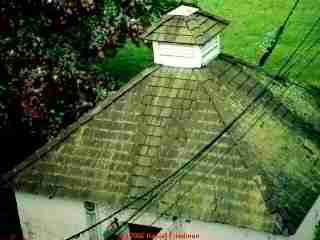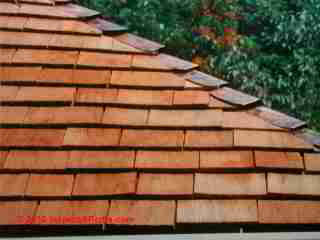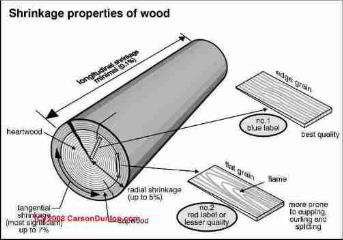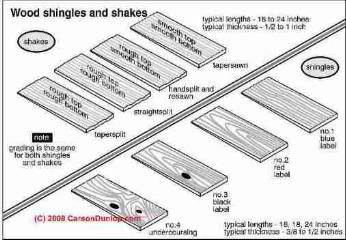 Wood Shingle & Wood Shake Roofs
Wood Shingle & Wood Shake Roofs
Wood Roof Identification, Inspection, Installation Details, Photo Guide
- POST a QUESTION or COMMENT about wood shingle roofing
Wood shingle or shake roofing summary guide:
Beginning here in this wood shingle & shake roof article series, we illustrate and discuss the installation, inspection, diagnosis, & repair of wood shingle & wood shake roofing in historic and contemporary use, we describe proper wood shingle or wood shake roof installation details, and we provide a wood roof inspection checklist.
Our page top photo shows a lichens and moss covered roof located in Key West, Florida, viewed from the Key West lighthouse.
InspectAPedia tolerates no conflicts of interest. We have no relationship with advertisers, products, or services discussed at this website.
- Daniel Friedman, Publisher/Editor/Author - See WHO ARE WE?
A Brief History of Wood Roofing in the U.S.
 Here we discuss wood roof shingles and shakes, product choices, types, installation manuals & inspection for defects, damage, or leaks in wood shingle or shake roofs.
Here we discuss wood roof shingles and shakes, product choices, types, installation manuals & inspection for defects, damage, or leaks in wood shingle or shake roofs.
In this article series we address key design details & references for wood shingle roofs. Wood roof inspection checklist.
If you are not sure of the difference between a wood shingle and a wood shake, wood shingles are saw-cut and have smooth flat surfaces, while wood shakes are split (by hand or by machine) to produce a thicker and more irregular product.
[Click to enlarge any image]
As Carson Dunlop Associates point out in their Home Reference Book, most wood shingles are white cyprus (most durable), cedar (western red cedar or white cedar) but in some locales redwood shingles are also used, and white pine shingles, yellow pine,and spruce have been used.
According to the US NPS "Roofing for Historic buildings":
Wood roofing shingles were commonplace in early America not only because of the abundance of timber, but also because of the relative ease with which they could be fabricated and installed. Made from the heartwood of a variety of locally available trees, early shingles were hand split with a mallet and froe and then dressed or smoothed with a draw knife to ensure they would lay flat on the roof.
The introduction of water and, then, steam powered saws in the early 19th century revolutionized the shingle industry by making possible the mass production of uniformly cut and smoothly finished shingles that required no hand dressing. As early as 1802, for example, N. Combes of Lamberton, New Jersey, informed the public that he now had a shingle dressing machine that had been newly invented by 'D[avid] French of Connecticut.
This machine at one stroke shaves the Shingle complete; at the second stroke it joints the same, and this done much more complete than it is possible to have it done by hand, in the usual way (The True American, Trenton, December 6, 1802).
The number of inventions for new types of shingle machines, as well as refinements to existing ones, quickly multiplied as the century advanced; at least nineteen patents were issued in 1857 alone for shingle making machines.
Despite such technological advances, hand split shingles never entirely disappeared. In fact, during most of the 19th century a thriving split shingle industry existed in southern New Jersey. Interestingly, much of the wood used in these shingles came from white cedar logs that had been buried in swamps and then "mined" or raised by shinglers who probed the area for suitable logs.
Reportedly a good shingler could tell merely by smell whether a log had been blown down or broken off, the former being the more desirable since it was less likely to be decayed. Once loosened from the peat, the log floated in the water, where it was sawn into blocks and then split into shingles.
An expert worker could mine and shave up to 1,000 shingles a week. Besides supplying local markets, South Jersey's mined shingles were shipped to cities and towns up and down the Delaware River, including Philadelphia.
Although wood shingles received strong competition from other roofing materials in the 19th century, they enjoyed renewed popularity in the late 19th and early 20th centuries with the introduction of the various revival styles of architecture.
Wooden shingles were steamed and bent to resemble thatched roofs on Tudor Revival homes, laid in evenly spaced overlapping horizontal rows on Colonial Revival houses, and used with abandon on the roofs and sides of Shingle Style buildings.
Today, although wood shingles represent a relatively small percentage of the roofing market, they remain a fashionable material for custom houses as well as restoration projects.
Wood Roofing Shingle Quality & Types
Wood roofing shingles and shakes
material cost $150-200 per square, with an installed cost of $130 - $160 / square. Wood shingle roofs have a typical life expectancy of 10-40 years, and weigh 300-400 pounds per square. The life of a wood shingle roof can vary widely depending on the wood species of shingles used and the treatment of wood roof shingles with preservative.
Wood shingles are sawn in 16", 18" and 24" lengths and are installed overlapped to produce three layers of shingle material covering the roof.
Wood shakes (a split rather than sawn product) are thicker than sawn wood shingles (but can still have splitting or installation defects).
Five wood species are cut or split into shingles or shakes: cypress wood shingles (rot resistant but need preservative treatment, red cedar wood shingles, (naturally durable on roofs), redwood roof shingles (rot resistant but need preservative treatment), SYP or southern yellow pine shingles (not usually used on roofs), and white cedar shingles (should not be used on roofs because of its short life in that application.

Carson Dunlop Associates' sketch (left) illustrates a source of variation in the quality of wood shingles that depends on how the shingles are cut from the log.
The Carson Dunlop sketch below illustrates the different qualities of wood shingles and wood shakes used on roofs.
Details about wood shingle and wood roof shake quality, types, warranties, & treatments are found
at WOOD ROOF SHINGLE PROPERTIES.
Preservatives & Fire Retardants Used on Wood Shingle or Shake Roofs
Wood roof preservatives can make a significant difference in the life expectancy (and in some cases fire resistance) of wood shingle or wood shake roofs, depending on the wood species of the shingles or shakes (see above) and the preservative used.
Traditionally wood shingle and shakes were treated with copper or copper arsenate compounds to resist insects and rot; some shingle and shake treatments include chemicals that help the roof resist oxidation from sun exposure as well.
Traditional CCA wood treatments turned the roof shingles or shakes green, a color that bleached out to a more natural color after a few months. Contemporary wood roof treatments may not turn the roof green, but they may include pigments that assist in resistance to sunlight and oxidation.
Other wood roof preservatives used tin compounds instead of copper, a less long-lasting treatment, and current treatments may use borate salts. Common current wood shingle and shake preservative treatments use products that combine a water repellant, pigment, and a preservative chemical. Pre-treated wood shingles and shakes are provided by some wood roof manufacturers: these products should not require additional coatings.
Watch out: we do not recommend using paints (such as alkyd or latex paint) on wood shingles, especially on wood roofs. Painting one side of wood roof shingles or shakes may accelerate their wear (shorten the roof life) by interfering with shingle or shake drying when the roof becomes wet. Painted roof shingles may split prematurely.
Chemical treatments for wood roofs are required (if wood shingle or shake roofs are permitted at all) in certain dry areas or areas prone to wildfires such as California. If you live in a high fire-risk zone and want the appearance of a wood shingle or shake roof, investigate roof shingles made of recycled materials and sold in products that look like wood shakes or slate.
Details about wood roof coatins and wood roof fire ratings are found
at WOOD ROOF COATINGS & FIRE RATINGS
Side-lap Wood Shingle Roofs
See "FABRICATING and INSTALLING Side-Lap Roof Shingles
in Eastern Pennsylvania", [PDF] James Houston & John N. Fugelso.
Quoting from that article:
In order to restore some of
Pennsylvania’s historic buildings,
the authors are recovering a lost
trade practice.
Over the past decade of working on
side-lap-shingle roofs, the authors have
observed many earlier attempts by
others to make the process of replicating
these roofs faster and less expensive.
These attempts have included substituting materials, sawing and planing shingles rather than riving them to speed the manufacturing process, and adding other materials between courses to reinforce the roofing system. All of these attempts have saved money and time in the short term but have failed to perform long enough to realize the savings.
Note: wood shake & shingle nails or fasteners are discussed at WOOD ROOF INSTALLATION SPECS and also under wood shingle siding at SIDING WOOD SHINGLE INSTALLATION
Useful Wood Shingle Roof Repair & Restoration References
- "Choosing Roofing," Jefferson Kolle, January 1995, No. 92, Fine Homebuilding, Taunton Press, 63 S. Main St., PO Box 5506, Newton CT 06470 - 800-888-8286 - see http://www.taunton.com/FineHomebuilding/ for the magazine's website and for subscription information.
- EASTERN WHITE CEDAR SHINGLE INSTALLATION GUIDE [PDF], Bardobec Inc. 51, rang Sainte-Marie St-Just-de-Bretenières (Québec) G0R 3H0 Canada, Website: http://bardobec.com/, Tel: 418-244-3612, also posted at Russin Lumber Corporation, 21 Leonards Drive Montgomery, New York, 12549 USA, Tel: 1-800-724-0010 Email: sales@russinlumber.com retrived 2017/05/13, original source: http://www.russinlumber.com/BARDOBEC_INSTALLATION_INSTRUCTIONS.pdf
- Problems in Roofing Design, B. Harrison McCampbell, Butterworth Heineman, 1991 ISBN 0-7506-9162-X (available used)
- Cedar Shake & Shingle Bureau, NEW ROOF CONSTRUCTION MANUAL [PDF] 2020 Cedar Shake & Shingle Bureau, PO Box 1178, Sumas, WA 98295-1178, USA / Canada: 300 – 34334 Forrest Terrace, Abbotsford, BC V2S 1G7 Canada, Web: https://www.cedarbureau.org/ CCSB - retrieved 2022/07/12, original source: https://www.cedarbureau.org/wp-content/uploads/2020/04/roof-manual-2020.pdf
- "Treatment of Cedar Shakes and Shingles," David Flickinger, RRO, Professional Roofing, October 1999, Rosemont IL.
- FABRICATING AND INSTALLING SIDE-LAP ROOF SHINGLES IN EASTERN PENNSYLVANIA [PDF] James Houston & John N. Fugelso, Web Search 07/12/2010
- FROM ASBESTOS TO ZINC, ROOFING FOR HISTORIC BUILDINGS, METALS-PART IV, WOOD [PDF] Technical Preservation Services, National Park Service, U.S. Department of the Interior, web search 9./29.10, original source:
http://www.nps.gov/history/hps/tps/roofingexhibit/slate.htm - Park, Sharon C., THE REPAIR and REPLACEMENT of HISTORIC WOODEN SHINGLE ROOFS [PDF] servation Brief No. 19, Sharon C. Park, AIA, Technical Preservation Services, National Park Service, U.S. Department of the Interior, retrieved 2018/11/15, original source: https://www.nps.gov/tps/how-to-preserve/preservedocs/preservation-briefs/19Preserve-Brief-WoodenShingle.pdf (Washington, D.C.: U. S. Dept. of the Interior, 1989
- Johan Heinrich Jonas Gudehus, “Journey to America” (1829), trans. Larry M. Neff, re- printed in the Publications of The Pennsylvania German Society 14 (1980), 307. “The houses of the Americans as well as their farm buildings have wooden shingle roofs that are so thick and solid that a ray of light can come through nowhere. These roofs are painted red, brown or dark blue with oil color and on most of them is to be found a lightning rod…”
- Robert C. Bucher, “The Long Shingle,” Pennsylvania Folklife 18, no. 4 (summer 1969): 51–56. This article was the first study of side- lap shingles and the primary source of basic information for "Fabricating and Installing ... " above.
- Waska, INSTALLING EASTERN WHITE CEDAR SHINGLES [PDF] Waska, division of Clair Industrial Dev. Corp Ltd 14, 2nd Avenue Industrial Clair NB, E7A 2B1 Offices in Canada and the U.S., Toll Free: 1-877-992-2152 Email: info@waska.com - retrieved 2022/07/05 original source: https://waska.com/data/775-installation_guide_waska_cedar_shingles_2016.pdf
- Waska, INSTALLING WOOD SHINGLES SHINGLES TECHNICAL INFO [PDF] Waska, retrieved 2022/07/05 original source: https://waska.com/data/775-installation_guide_waska_cedar_shingles_2016.pdf
- Waska INSTALLATION for CEDAR BREATHER SHINGLE [PDF] Waska, retrieved 2022/07/05 original source: https://waska.com/data/468-inst_cedar_shingle.pdf
- For Wood Shingle Wall installation see
SIDING WOOD SHINGLE INSTALLATION - best practices - Also see additional sources atReferences or Citations below
...
Continue reading at WOOD ROOF INSTALLATION SPECS or select a topic from the closely-related articles below, or see the complete ARTICLE INDEX.
Or see these WOOD SHINGLE & SHAKE ROOF FAQs - Questions & answers posted originally on this page
Or see these
Recommended Articles
- ROOF VENTILATION, FIRE RESISTANT
- SIDING WOOD SHINGLE INSTALLATION - best practices
- WOOD SHAKE & SHINGLE ROOFING - home
- WOOD ROOF COATINGS & FIRE RATINGS
- WOOD ROOF FLASHING DETAILS
- WOOD ROOF HIP & RIDGE DETAILS
- WOOD ROOF INSPECTION GUIDE
- WOOD ROOF INSTALLATION SPECS
- WOOD ROOF LIFE EXPECTANCY
- WOOD ROOF MAINTENANCE
- WOOD ROOF MOSS & LICHENS
- WOOD ROOF SHAKES INSTALLATION
- WOOD ROOF SHEATHING, UNDERLAYMENT
- WOOD ROOF SHINGLE PROPERTIES
- WOOD ROOF WEAR / INSTALLATION DEFECTS
- WOOD SHINGLES, RE-ROOFING WITH
Suggested citation for this web page
WOOD SHAKE & SHINGLE ROOFING at InspectApedia.com - online encyclopedia of building & environmental inspection, testing, diagnosis, repair, & problem prevention advice.
Or see this
INDEX to RELATED ARTICLES: ARTICLE INDEX to BUILDING ROOFING
Or use the SEARCH BOX found below to Ask a Question or Search InspectApedia
Ask a Question or Search InspectApedia
Questions & answers or comments about wood shingle roofing.
Try the search box just below, or if you prefer, post a question or comment in the Comments box below and we will respond promptly.
Search the InspectApedia website
Note: appearance of your Comment below may be delayed: if your comment contains an image, photograph, web link, or text that looks to the software as if it might be a web link, your posting will appear after it has been approved by a moderator. Apologies for the delay.
Only one image can be added per comment but you can post as many comments, and therefore images, as you like.
You will not receive a notification when a response to your question has been posted.
Please bookmark this page to make it easy for you to check back for our response.
IF above you see "Comment Form is loading comments..." then COMMENT BOX - countable.ca / bawkbox.com IS NOT WORKING.
In any case you are welcome to send an email directly to us at InspectApedia.com at editor@inspectApedia.com
We'll reply to you directly. Please help us help you by noting, in your email, the URL of the InspectApedia page where you wanted to comment.
Citations & References
In addition to any citations in the article above, a full list is available on request.
- Best Practices Guide to Residential Construction, by Steven Bliss. John Wiley & Sons, 2006. ISBN-10: 0471648361, ISBN-13: 978-0471648369, Hardcover: 320 pages, available from Amazon.com and also Wiley.com. See our book review of this publication.
- Mark Cramer Inspection Services Mark Cramer, Tampa Florida, Mr. Cramer is a past president of ASHI, the American Society of Home Inspectors and is a Florida home inspector and home inspection educator. Mr. Cramer serves on the ASHI Home Inspection Standards. Contact Mark Cramer at: 727-595-4211 mark@BestTampaInspector.com
- John Cranor [Website: /www.house-whisperer.com ] is an ASHI member and a home inspector (The House Whisperer) is located in Glen Allen, VA 23060. He is also a contributor to InspectApedia.com in several technical areas such as plumbing and appliances (dryer vents). Contact Mr. Cranor at 804-873-8534 or by Email: johncranor@verizon.net
- Our recommended books about building & mechanical systems design, inspection, problem diagnosis, and repair, and about indoor environment and IAQ testing, diagnosis, and cleanup are at the InspectAPedia Bookstore. Also see our Book Reviews - InspectAPedia.
- Best Practices Guide to Residential Construction, by Steven Bliss. John Wiley & Sons, 2006. ISBN-10: 0471648361, ISBN-13: 978-0471648369, Hardcover: 320 pages, available from Amazon.com and also Wiley.com. See our book review of this publication.
- Decks and Porches, the JLC Guide to, Best Practices for Outdoor Spaces, Steve Bliss (Editor), The Journal of Light Construction, Williston VT, 2010 ISBN 10: 1-928580-42-4, ISBN 13: 978-1-928580-42-3, available from Amazon.com
- The Journal of Light Construction has generously given reprint permission to InspectAPedia.com for this article. All rights and contents are ©Journal of Light Construction and may not be reproduced in any form.
- Architectural elements: the technological revolution: Galvanized iron roof plates and corrugated sheets; cast iron facades, columns, door and window caps, ... (American historical catalog collection), Diana S Waite, available used out of Amazon.
- Handbook of Building Crafts in Conservation, Jack Bower, Ed., Van Nostrand Reinhold Company, NY 1981 ISBN 0-442-2135-3 Library of Congress Catalog Card Nr. 81-50643.
- Historic Preservation Technology: A Primer, Robert A. Young, Wiley (March 21, 2008) ISBN-10: 0471788368 ISBN-13: 978-0471788362
- Metal Roofing, an Illustrated Guide, R.A. Knowlton , [metal shingle roofs],
- Patio Roofs, how to build, Sunset Books
- Problems in Roofing Design, B. Harrison McCampbell, Butterworth Heineman, 1991 ISBN 0-7506-9162-X (available used)
- Roofing The Right Way, Steven Bolt, McGraw-Hill Professional; 3rd Ed (1996), ISBN-10: 0070066507, ISBN-13: 978-0070066502
- Slate Roofs, National Slate Association, 1926, reprinted 1977 by Vermont Structural Slate Co., Inc., Fair Haven, VT 05743, 802-265-4933/34. (We recommend this book if you can find it. It has gone in and out of print on occasion.)
- Wood Shingle Roofs, Care and Maintenance of wood shingle and shake roofs, (EC), Stanley S. Niemiec (out of print)
- In addition to citations & references found in this article, see the research citations given at the end of the related articles found at our suggested
CONTINUE READING or RECOMMENDED ARTICLES.
- Carson, Dunlop & Associates Ltd., 120 Carlton Street Suite 407, Toronto ON M5A 4K2. Tel: (416) 964-9415 1-800-268-7070 Email: info@carsondunlop.com. Alan Carson is a past president of ASHI, the American Society of Home Inspectors.
Thanks to Alan Carson and Bob Dunlop, for permission for InspectAPedia to use text excerpts from The HOME REFERENCE BOOK - the Encyclopedia of Homes and to use illustrations from The ILLUSTRATED HOME .
Carson Dunlop Associates provides extensive home inspection education and report writing material. In gratitude we provide links to tsome Carson Dunlop Associates products and services.


